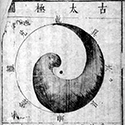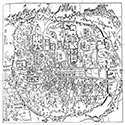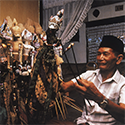|
|
| Show All 73 Results (Text Only) |
|
| The Story of Rama [PDF] |
|
|
In this unit, students are introduced to the basic background of Balinese Hinduism and to one of its main texts, the Ramayana (The Story of Rama), about a prince and his long hero’s journey. It began in India and spread among many countries throughout Asia. Its text is a major thread in the culture, religion, history, and literature of millions.
Go to Museum Resource: https://education.asianart.org/wp-content/uploads/sites/6/2019/10/Rama.pdf | |
|
|
| Taoism and the Arts of China [PDF] |
|
|
"This packet introduces Taoism, and its expression in Chinese art. What exactly is Taoism? (pronounced “dow-ism”) The “Tao” (pronounced “dow”) is change, motion, energy, the source of all matter and creation. It unfolds as the interaction of two kinds of energy (qi, pronounced “chee”), called yin and yang. These two energies interact in a state of constant movement. Taoism is a world of beliefs, writings, ceremonial practices, philosophies, and art that strives to harmonize the life of human beings with the forever and naturally changing universe. Like any religion or set of indigenous beliefs, Taoism has evolved over the centuries to encompass many ideas, mythologies and cultural practices."
Go to Museum Resource: https://education.asianart.org/wp-content/uploads/sites/6/2019/09/Taoism-Teache... | |
|
|
| Temple, Palace, Scholar’s House: Three Settings of Traditional Korean Culture [PDF] |
|
|
This packet introduces teachers and other readers to several traditional settings of Korean culture: Buddhist temples, palaces, and scholar’s houses, as well as Confucian academies where scholars were trained. These settings provide a framework or backdrop for many of the historical art objects on display at the museum.
Go to Museum Resource: https://education.asianart.org/wp-content/uploads/sites/6/2019/09/Temple-Palace... | |
|
|
| Tomb Treasures: Explore a Tomb from China’s Han Dynasty |
|
|
Explore a virtual tomb: Tomb Treasures exhibition and assembled using photography and reference material provided by the Nanjing Museum, the Tomb Treasures 3D Experience begins with an aerial view of a reconstructed Han Dynasty royal mausoleum; the burial mound is lifted to reveal Tombs 1 and 2 prior to presenting an interactive 3D of Tomb 1. Explore 12 different areas of the tomb, where different objects were discovered.
Go to Museum Resource: https://education.asianart.org/resources/explore-a-tomb-from-chinas-han-dynasty... | |
|
|
| The Underground Army of the First Emperor |
|
|
Just east of the modern city of Xi’an, you can see an army of soldiers unearthed. Discovered first in 1974, the work continues on three pits containing over 7,000 model soldiers. The army was buried within a framework of wooden pillars just east of the large tumulus containing the tomb of the First Emperor. It was a massive undertaking, certainly the largest ceramic project ever undertaken anywhere.
Go to Museum Resource: https://education.asianart.org/resources/the-underground-army-of-the-first-empe... | |
|
|
| A Visual Vocabulary of Brush Painting |
|
|
The brush painting artist can achieve a multitude of effects by varying such factors as the speed and pressure applied to a brush, the size and type of brush, the amount of moisture, the manner in which different shades of ink or colors are loaded onto the brush, the angle at which the brush is held, and the type of paper or silk used for painting. Above are examples, drawn from the museum’s collection, which represent some of the more common techniques. Includes download of visual guide and instructions.
Go to Museum Resource: https://education.asianart.org/resources/a-visual-vocabulary-of-brushstrokes/ | |
|
|
| Warrior Kings and Divine Jesters: Indonesian Rod Puppets [PDF] |
|
|
This packet is designed to give an introduction to the world of Indonesian three-dimensional rod puppet theater (wayang golek) and to the stories told in performances using these puppets. Stories include Islamic and Javanese historical tales as well as Indonesian versions of the Ramayana, the epic story of the hero Rama.
Go to Museum Resource: https://education.asianart.org/wp-content/uploads/sites/6/2019/12/WarriorKingsD... | |
|
|
| Words as Art/Art with Words: Chinese Calligraphy Teacher Packet [PDF] |
|
|
"How do you integrate words and art to express an idea? China’s educated elite painted artful writing, more commonly known as calligraphy, since at least the Han dynasty (206 BCE–220 CE). Chinese calligraphy is a visual art. The fluid strokes, dots and lines that form each character are its focus. The content of a calligraphic work, while sometimes inspiring or moving, is usually nothing new. What is fresh, exciting, and creative is the way it is visually expressed. In China, painting and writing developed hand in hand, sharing the same tools and techniques..."
Go to Museum Resource: https://education.asianart.org/wp-content/uploads/sites/6/2019/09/Calligraphy-w... | |
|
|
|
| Show All 73 Results (Text Only) |








